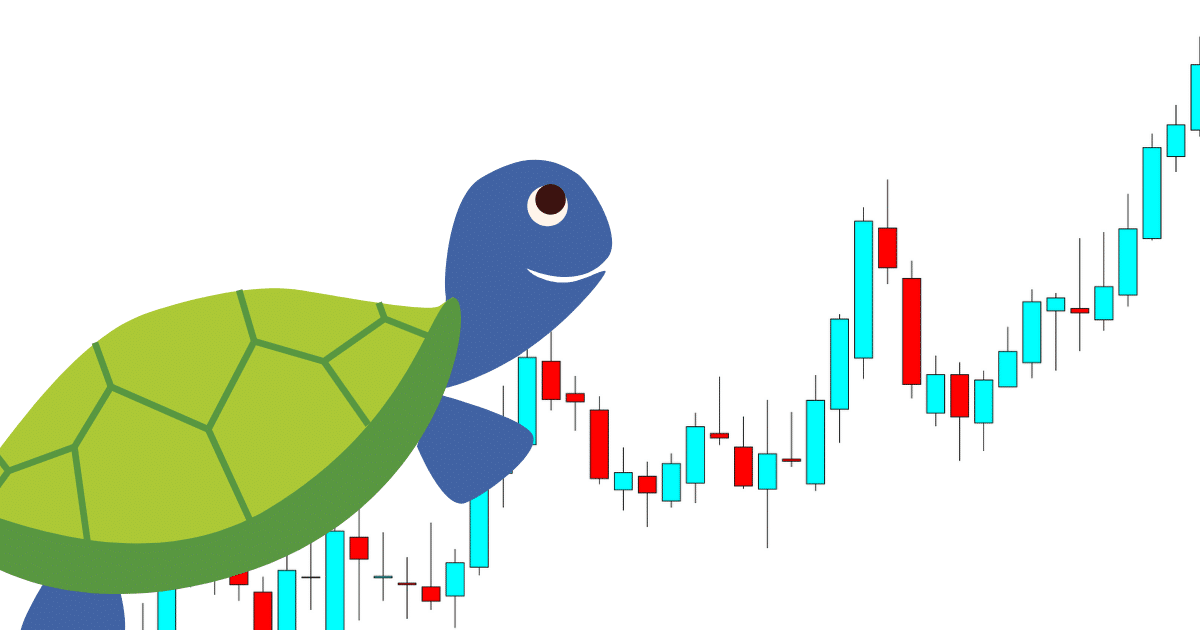By following a simple rule set, can a novice trader become an outstanding professional trader in a short period of time?
Pablo Picasso said, “Learn the rules like a pro, so you can break them like an artist”.
A man named Richard Dennis trained a group of non-professional traders into the ‘Turtle Traders’ who then went onto make $100 million dollars, proving this can be done.

Table of Contents
Who are the Turtle Traders?
The turtle traders are one of the most compelling experiments in the history of trading.
It all started with two men named Richard Dennis & William Eckhardt. The two commodity traders were having an ongoing dispute about whether a great trader’s skill could be reduced to a set of fixed rules.
To settle this matter, Dennis suggested that they recruit and train traders to see which one is correct. They then took out a large advertisement asking for trading apprentices in Barron’s, the Wall Street Journal and the New York Times.
The successful applicants consisted of 21 men and 2 women. They were invited to Chicago for two weeks of training and trading with small accounts. After proving themselves, Dennis funded the recruit traders with one million dollar accounts.
Dennis was quoted as saying;
“We are going to grow traders like they grow turtles in Singapore”.
As a result, the traders were called “the turtles”.
The ‘turtle traders’ became one of the most famous experiments in the history of trading because they went on to earn an aggregated sum of over $100,000,000 dollars.
With a simple set of rules, Dennis proved that he could turn a novice trader into an excellent trader. The turtle trader story is an inspiration that still inspires modern day traders today.
Richard Dennis & William Eckhardt
Who is Richard Dennis?
Richard Dennis was once known as the “Prince of the Pit”.
He is a famous commodities speculator and reportedly made $200 million in about 10 years with the $1,600 money he borrowed.
He started his career in commodities when he was only 17 years old as a floor trader order runner at Chicago Mercantile Exchange.
Using mini contracts, he started to trade his own account at the Mid America Commodity Exchange. In 1973, Richard Dennis earned $100,000 in profit.
In 1974, he capitalized on a runway soybean market to make $500,000 in profits. At the end of 1974, he became an outstanding millionaire.
Who is William Eckhardt?
William Eckhardt is a commodity and futures trader and fund manager.
In 1991 he founded Eckhardt Trading Company (ETC), an alternative investment management firm. It specializes in the trading of global financial futures and commodities.
Eckhardt is a trader and friend of Richard Dennis who was involved in the turtle trader experiment.
The Turtle Trading Strategy and Rules
The turtle traders were taught how to implement a trend following strategy by Richard Dennis. The idea is to buy futures breaking out to the upside of the trading range and sell short when the downside breaks out.
This is a strategy where you attempt to ride the momentum of an asset, whether it is trending up or down.
The turtle trading system is a rule-based system developed by Richard Dennis where the turtles became successful traders. The system includes every aspect a trader needs to know, including how to trade, how much to buy and sell, and importantly when to get out of a trade.
What Markets Did the Turtle Trade?
In general; the turtles traded large and liquid markets due to the size of the trades they were entering into.
Except for meat and grains, they traded all the liquid markets.
Here’s an idea of what the turtles traded:
- 10 & 30 Year U.S. Treasury Bond & 90 Day U.S. Treasury Bills.
- Commodities: cocoa, coffee, cotton, sugar, heating oil, crude oil, and unleaded gas.
- Currencies: Swiss Franc, British Pound, Japanese Yen, and Canadian dollar.
- Metals: gold, silver, and copper.
- Index Futures
Position Sizing
When it came to position sizing, the turtle traders used a sophisticated position sizing algorithm. They based the size of their positions on the volatility of an asset.
If a turtle amassed a position in a highly volatile market, it would be offset by a position in a lower volatility market.
With the information provided by Dennis, the turtles could figure out how much they should hold on each trade position.
In a highly volatile market, the turtles would have smaller amounts. On the other hand, they would have larger amounts in a low volatility market.
Pyramiding Into Positions
The turtles used “pyramiding” to take larger positions if the market moved in their favor. This could increase their profits when they made large winning trades.
They also added one unit to the position each time the price moved favorably. This was not the actual breakout price because this was based on the transaction price.
How Turtles Entered Trades
The turtle traders used two simple entry systems:
The short-term system based on 20-day breakout
They entered (one unit) when the price moved above the high for the last 20 days or dropped below the low of the last 20 days.
The long-term system based on 55-day breakout
They entered (one unit) when the price moved above the high for the last 55 days,
The turtles always ended a trade on the breakout before the daily close of the markets.
How Turtles Exited Trades
The turtle traders used a stop loss at all times to make sure their losses did not spiral out of control.
All stop losses were worked out before the trades entry and similar to their position sizing they employed different stops depending on the volatility of the market. The more volatile the market, the wider the stop that would be used so that trades would not be whipsawed out before going on to become winners.
Lastly
Turtle trading is one of the most famous experiments to have ever been recorded in the history of trading.
By following a clear cut and simple rule set, profit become consistent.
This strategy worked well in Dennis’s era. Trends still occur in all markets opening the way for a lot of opportunities for traders to create their own trend trading systems and rule sets.
“Trading was even more teachable than I imagined… In a strange sort of way it was almost humbling”
-Richard Dennis
Wall Street Journal

